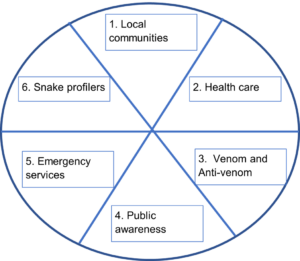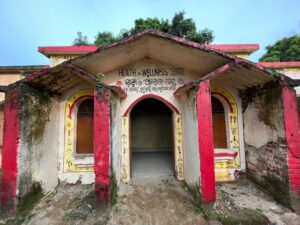Shine Light on an ADN’s Project: Avoidable Snakebite Deaths
Dr Nibedita S. Ray-Bennett and Ms Lauren Macleod
This year the Avoidable Deaths Network explored the feasibility and value of two novel networking models: the knowledge exchange network (KEN) model for technical experts and the local-level action network (LAN) for high-risk groups. Worldwide, 2.7 million people are bitten by venomous snakes each year resulting in up to 138,000 deaths and 400,000 amputations and other permanent disabilities (WHO, 2023).
India is the global hotspot for snakebite deaths with annual deaths around 58,000 and a further 140,000 incidents leading to various disabilities including limb injuries and amputations. Envenoming occurs when particular types of snakes inject a toxic secretion via a bite delivered to victims. About 75% of snakebite deaths in India occur in rural areas before reaching hospitals, and half of all deaths occur from June to September during the monsoon season. This season is notorious for flooding in the South Asian sub-continent.
Deaths from snakebites during floods or disasters are known as indirect disaster deaths (Ray-Bennett et al., 2023). Reducing disaster deaths is currently the United Nations ‘Sendai Framework for Disaster Risk Reduction’ first global target. This global target is consistent with the World Health Organisation’s Snakebite Envenoming Strategy for Prevention and Control, which urges national governments to halve snakebite deaths by 2030. The Government of India has ratified both Frameworks, as such, it is imperative that reducing snakebite deaths is given utmost priority for disaster-resilient sustainable development.
In collaboration with 14 organisations[1] and 11 gatekeepers,[2] we assessed the feasibility of the KEN and LAN platforms. More concretely, we explored: who are these stakeholders, and how can we engage with them to assess the feasibility of KEN and LAN to promote risk-informed sustainable development. We conducted stakeholder mapping from the village- to national levels across three states, viz, Odisha, Madhya Pradesh and Assam, and consulted with relevant stakeholders virtually and in person. We also used a model of one district, one district and one village of the same district model to conduct interviews and focus group discussions. Please see Table 1: One District Model below for the names of selective districts, and villages. All these activities were conducted from January to July 2023.
Table 1: One District Model
| State | Odisha | Madhya Pradesh | Assam |
| District | Ganjam | Seoni | Bongaigaon |
| Sub-District | Kodala Tehsil | Lakhnadon Tehsil | North Salmara |
| Village | Burujhari | Purwa | Kayethpara |
We found six evidence-based categories of stakeholders for KEN, specifically local communities, health care, venom and anti-venom, public awareness, emergency services and snake profilers. These stakeholders cross-cut nine sectors/state departments (see Figure 1: Category of Stakeholders).

For LAN we found 17 stakeholders at the district level; one at the sub-district level; and nine at the village level.
We engaged with some of the KEN and LAN stakeholders through a two-day-long hybrid symposium in Bhubaneswar in Odisha where ADN India Hub is located. Through the Symposium, focus group discussions and interviews, we found that there is an appetite for networking. However, to engage with high-risk groups, we need to be present in villages and work with them.
On 19 September 2023, in collaboration with ADN India Hub in Bhubaneswar, we launched a field research Case Station for Avoidable Snakebite Deaths (CaSA) in Burujhari village of Ganjam district in Odisha to work with high-risk groups. The village of Burujhari of Ganjam district carries the highest number of snakebites in Odisha due to its proximity to coastal jungles, warm and humid climate and high population density. Agricultural workers are most at risk of snakebites from poisonous Cobra, Common Krait, Russell’s Viper and the Indian Rock Python. With limited knowledge about snakes, their behaviour, and appropriate preventive measures, villagers are at risk of fatalities. Furthermore, the risk increases because the nearest medical facility is located 85 km away. Hence, the villagers rely on traditional healers.

The CaSA aims to promote a social learning laboratory; develop communities of practice (aka local level action network (LAN)) at Burujhari to find solutions for local problems; and based on our learning develop the capacity of primary and secondary health and disaster responders to reduce avoidable snakebite deaths. We will continue to provide updates from CaSA through the ADN’s Newsletter.
References
Ray-Bennett, N.S., MacLeod, L., Biswas, I., Samuel, S.P., Shiroshita, H. and Glovinsky, S. (2023) Exploring the Feasibility and Value of Pioneering Partnerships to Reduce Avoidable Snakebite Deaths in India. UK and Japan: Avoidable Deaths Network Publication.
World Health Organization (2023) Snakebite in India. Available at: https://www.who.int/india/health-topics/snakebite
Authors short bios:
Dr Nibedita Ray-Bennett is the Founding President of the ADN and an Associate Professor in Risk Management at the University of Leicester.
Ms Lauren MacLeod is ADN Research Administrator and an Activity Coordinator who coordinates activities related to the Global Campaign: International Awareness Day for Avoidable Deaths and the Country Chapters and Hubs.
[1] University of Leicester, PeerConnect, Kansai University, Sheffield University, All India Institute of Disaster Management, Orissa State Volunteers Social Worker’s Association, Tata Steel, Kalahandi University, Doers, Zoological Survey of India, Indian Council of Medical Research, Indian Council of Medical Research – National Institute of Research in Tribal Health, Demow Rural Community Health Centre, Snake Helpline and All India Institute of Medical Science.
[2] Ophirex, Inc., Climate Resilient Observing-Systems Promotion Council, Amrita Institute of Medical Sciences and Research Centre, Premium Serums, Madras Crocodile Bank Trust and Centre for Herpetology, Himachal Pradesh State Institute of Health and Family Welfare, EMRI Green Health Services, and Bongaigaon Civil Hospital and two independent snake rescuers.

